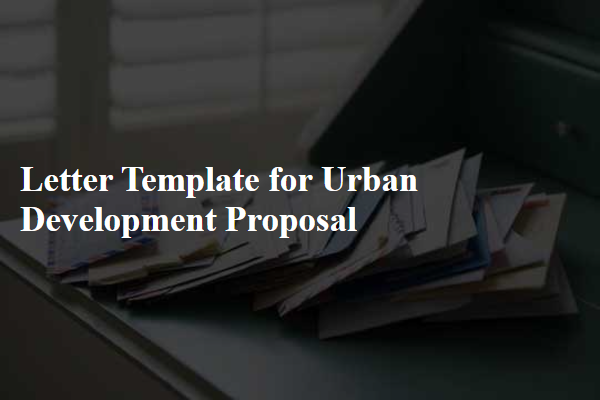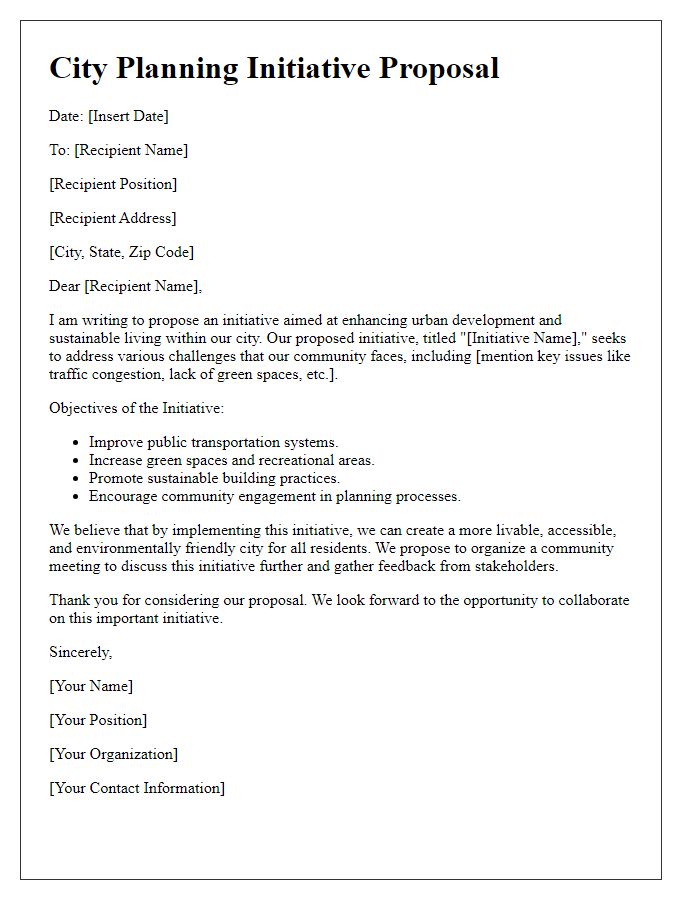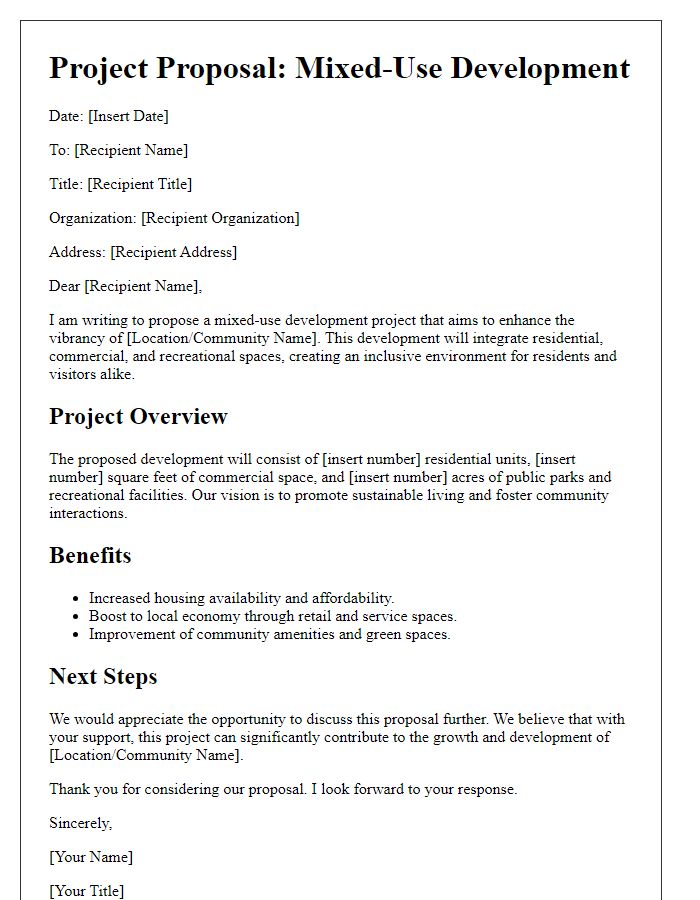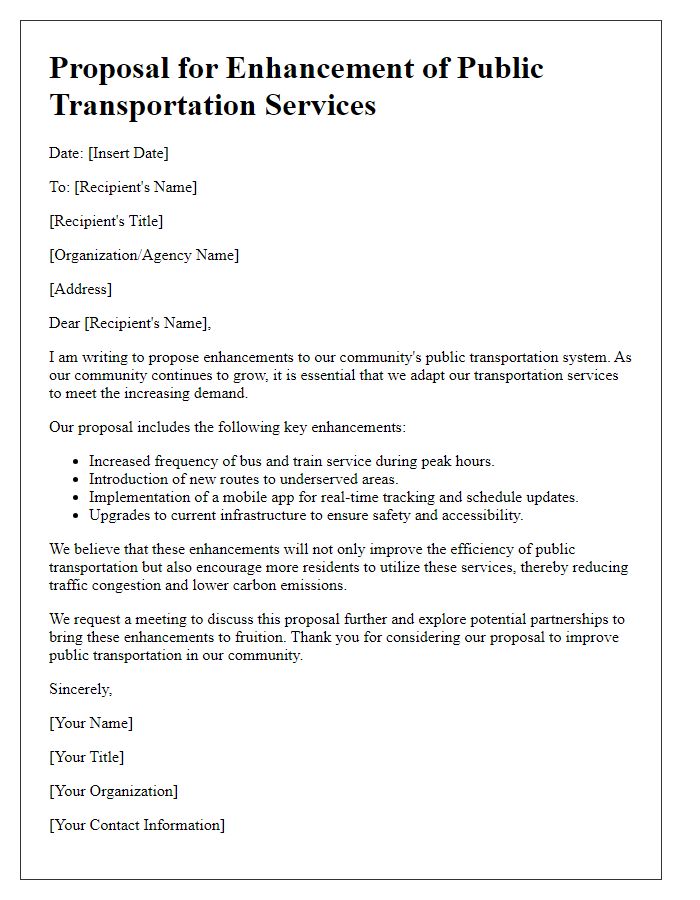Are you curious about the future of our urban spaces? In this article, we'll explore a comprehensive letter template that outlines a compelling urban development proposal designed to enhance community living and sustainability. From addressing the needs of local residents to promoting eco-friendly practices, we'll cover the essential elements that make a proposal stand out. Join us as we dive deeper into effective strategies for shaping vibrant urban environments, and discover how you can make a positive impact in your community!

Project Overview and Objectives
The urban development project focuses on transforming underutilized land in downtown Springfield (population 169,000) into a vibrant mixed-use community hub. This neighborhood revitalization aims to integrate residential, commercial, and recreational spaces, fostering a sense of community. Targeting a 15-acre site, the proposal seeks to create 500 residential units, 100,000 square feet of retail space, and a 10,000 square foot community center, promoting social interaction. Sustainable practices will guide the design, aiming for LEED certification (Leadership in Energy and Environmental Design), enhancing energy efficiency. The project envisions green spaces, such as parks with native flora, encouraging outdoor activities. Public transport accessibility will be prioritized, aiming to reduce carbon footprints and enhance connectivity. Overall, this initiative aspires to cultivate an inclusive environment, stimulate local economy, and establish Springfield as a model for future urban developments.
Stakeholder Engagement and Collaboration
The urban development proposal encompasses a detailed letter template highlighting stakeholder engagement and collaboration, essential components in fostering community involvement and ensuring project success. Stakeholders, including local residents, government officials, business owners, and community organizations, play a crucial role in shaping developmental initiatives, providing valuable insights, and promoting transparency. The template outlines a structured approach for outreach, inviting input through surveys, public meetings, and discussions to ensure diverse perspectives are considered. Effective collaboration not only strengthens relationships but also enhances the overall quality of urban planning, addressing issues such as sustainability, accessibility, and social equity. Continuous engagement fosters a sense of ownership among stakeholders, vital for long-term project viability and community satisfaction.
Environmental and Social Impact Assessment
Urban development projects often necessitate comprehensive Environmental and Social Impact Assessments (ESIAs) to ensure sustainable growth while minimizing harm to ecosystems and communities. Evaluations of air quality, noise pollution, and biodiversity must be conducted in accordance with local regulations, such as the National Environmental Policy Act (NEPA) in the United States. Communities affected by development--such as neighborhoods in metropolitan areas like New York City or Los Angeles--require thorough consultation to address concerns regarding displacement, access to resources, and potential job creation or loss. Data collection should involve socioeconomic metrics, including population density and local employment rates, to assess overall impact. Moreover, adhering to guidelines set forth by international organizations, like the World Bank, can enhance the project's social license to operate, foster community trust, and mitigate resistance from stakeholders.
Economic Viability and Funding Sources
Urban development proposals require a thorough analysis of economic viability and potential funding sources to ensure successful implementation and sustainability. Economic viability hinges on evaluating the projected return on investment (ROI), with detailed calculations indicating profitability over time. Available funding sources include local government grants, private investors, and federal programs designed to stimulate urban renewal, such as the Community Development Block Grant (CDBG). Public-private partnerships (PPPs) often play a crucial role, leveraging resources from both sectors to fund large-scale projects. Additionally, tax increment financing (TIF) can provide an effective mechanism to capture future tax benefits derived from increased property values within the development area. Researching state-specific funding opportunities and incentives is essential, as use of adaptive reuse strategies can qualify projects for historic preservation tax credits. Overall, a well-structured proposal outlining these economic aspects is vital for gaining support from stakeholders and ensuring that the urban development project thrives in a competitive market.
Implementation Timeline and Milestones
Urban development projects often involve a detailed implementation timeline and key milestones that help ensure progress. The initial phase typically encompasses site assessment and public consultations within the first three months, engaging community stakeholders in cities like San Francisco or Atlanta. Following this, a design phase begins, lasting approximately six months, where architects and urban planners create blueprints aligning with sustainability goals, such as LEED certifications. Development permits and environmental assessments are typically secured in the next quarter, allowing construction to begin within 12 months from project initiation. Key milestones include breaking ground on site, anticipated around 12 months, significant infrastructure installations like roads or public transport links by the 18-month mark, and completion of the first phase of residential units by two years, measuring urban density and livability before moving to commercial development phases thereafter. Regular evaluations will occur every six months to adjust the approach based on community feedback and project progress.













Comments